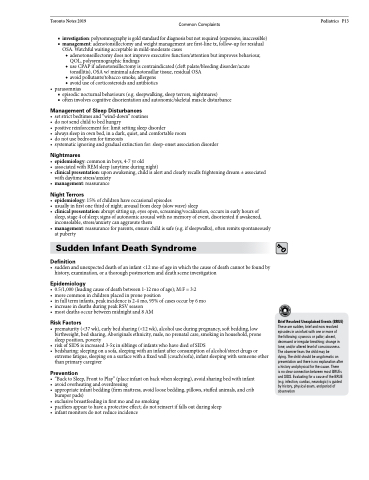Page 1047 - TNFlipTest
P. 1047
Toronto Notes 2019 Common Complaints
■ investigation:polysomnographyisgoldstandardfordiagnosisbutnotrequired(expensive,inaccessible) ■ management:adenotonsillectomyandweightmanagementarefirst-linetx,follow-upforresidual
OSA. Watchful waiting acceptable in mild-moderate cases
◆ adenotonseillectomy does not improve executive function/attention but improves behaviour,
QOL, polysymnographic findings
◆ use CPAP if adenotonsillectomy is contraindicated (cleft palate/bleeding disorder/acute
tonsillitis), OSA w/ minimal adenotonsillar tissue, residual OSA ◆ avoid pollutants/tobacco smoke, allergens
◆ avoid use of corticosteroids and antibiotics
• parasomnias
■ episodic nocturnal behaviours (e.g. sleepwalking, sleep terrors, nightmares)
■ often involves cognitive disorientation and autonomic/skeletal muscle disturbance
Management of Sleep Disturbances
• setstrictbedtimesand“wind-down”routines
• donotsendchildtobedhungry
• positivereinforcementfor:limitsettingsleepdisorder
• alwayssleepinownbed,inadark,quiet,andcomfortableroom
• donotusebedroomfortimeouts
• systematicignoringandgradualextinctionfor:sleep-onsetassociationdisorder
Nightmares
• epidemiology:commoninboys,4-7yrold
• associatedwithREMsleep(anytimeduringnight)
• clinicalpresentation:uponawakening,childisalertandclearlyrecallsfrighteningdream±associated
with daytime stress/anxiety • management:reassurance
Night Terrors
• epidemiology:15%ofchildrenhaveoccasionalepisodes
• usuallyinfirstonethirdofnight;arousalfromdeep(slowwave)sleep
• clinicalpresentation:abruptsittingup,eyesopen,screaming/vocalization,occursinearlyhoursof
sleep, stage 4 of sleep; signs of autonomic arousal with no memory of event, disoriented if awakened,
inconsolable, stress/anxiety can aggravate them
• management:reassuranceforparents,ensurechildissafe(e.g.ifsleepwalks),oftenremitsspontaneously
at puberty
Sudden Infant Death Syndrome
Definition
• suddenandunexpecteddeathofaninfant<12moofageinwhichthecauseofdeathcannotbefoundby history, examination, or a thorough postmortem and death scene investigation
Epidemiology
• 0.5/1,000(leadingcauseofdeathbetween1-12moofage);M:F=3:2
• morecommoninchildrenplacedinproneposition
• infullterminfants,peakincidenceis2-4mo,95%ofcasesoccurby6mo • increaseindeathsduringpeakRSVseason
• mostdeathsoccurbetweenmidnightand8AM
Risk Factors
• prematurity(<37wk),earlybedsharing(<12wk),alcoholuseduringpregnancy,softbedding,low birthweight, bed sharing, Aboriginals ethnicity, male, no prenatal care, smoking in household, prone sleep position, poverty
• riskofSIDSisincreased3-5xinsiblingsofinfantswhohavediedofSIDS
• bedsharing: sleeping on a sofa, sleeping with an infant after consumption of alcohol/street drugs or
extreme fatigue, sleeping on a surface with a fixed wall (couch/sofa), infant sleeping with someone other than primary caregiver
Prevention
• “BacktoSleep,FronttoPlay”(placeinfantonbackwhensleeping),avoidsharingbedwithinfant • avoidoverheatingandoverdressing
• appropriateinfantbedding(firmmattress,avoidloosebedding,pillows,stuffedanimals,andcrib
bumper pads)
• exclusivebreastfeedinginfirstmoandnosmoking
• pacifiersappeartohaveaprotectiveeffect;donotreinsertiffallsoutduringsleep • infantmonitorsdonotreduceincidence
Pediatrics P13
Brief Resolved Unexplained Events (BRUE)
These are sudden, brief and now resolved episodes in an infant with one or more of the following: cyanosis or pallor; absent, decreased or irregular breathing; change in tone; and/or altered level of consciousness. The observer fears the child may be
dying. The child should be asyptomatic on presentation and there is no explanation after a history and physical for the cause. There
is no clear connection between most BRUEs and SIDS. Evaluating for a cause of the BRUE (e.g. infection, cardiac, neurologic) is guided by history, physical exam, and period of observation


